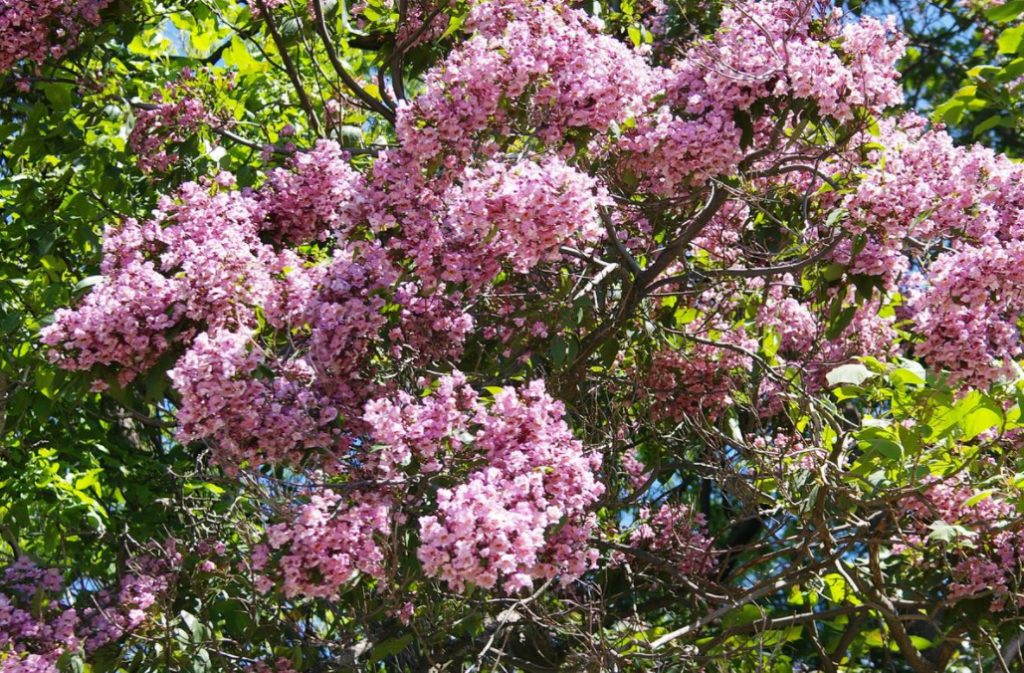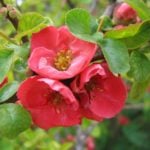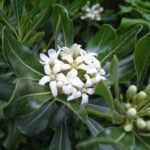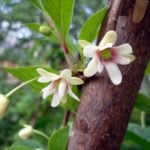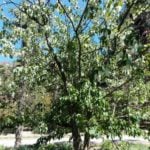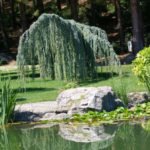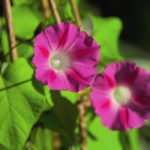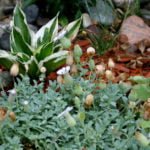In this article, we will talk about incredibly beautiful trees from the family Bignoniaceae and Scrophulariaceae with pink, lilac, blue and purple color options. The magic of their flowering is simply magical! All this is exotic, still a rarity for the garden, but it can also be different: subtropical and tropical. This is mainly devoted to subtropical dendroflora, as many other heat-loving rare species have long been successfully grown in indoor culture.
Jacaranda
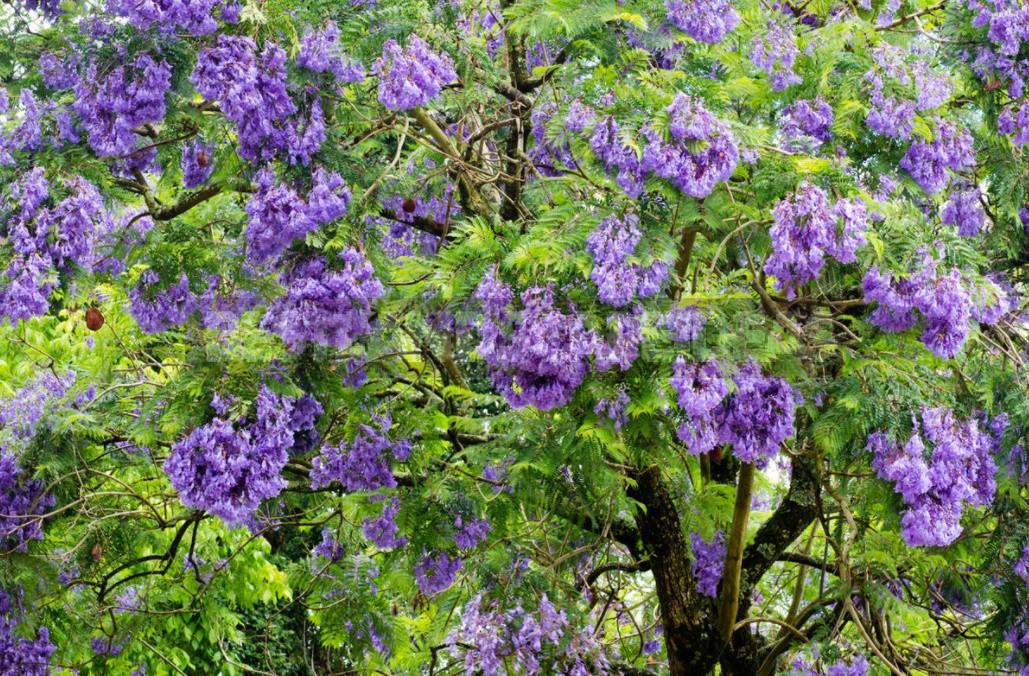
Jacaranda mimosifolia, or violet tree, received the species name for the similarity of the large double-feathered leaves with mimosa leaves. According to the Missouri Botanical Garden, winter hardiness corresponds to the 10-11 USDA zones, that is, temperatures close to -1.1°C (30.2°F) are already critical for it. Therefore, even in the southern regions, it is grown in a tub culture, for the winter bringing containers, tubs in a non-freezing room.
Growing and Reproduction
It should be borne in mind that young Jacaranda mimosifolia do not bloom. However, this does not stop gardeners from growing them: trees are loved for the beauty of not only charming blue-purple flowers, but also elegant leaves. Jacaranda looks more luxurious in open sunny places and well-drained fertile soils with regular watering. Do not allow, especially if it is a tub plant, to dry the soil substrate.
Catalpa
In addition to the familiar species with white flowers with a peculiar reddish-brownish speck — Catalpa ovata, C. bignonioides, C. speciosa – there are species and forms with very beautiful pink, lilac flowers. In addition, all catalpas from the family Bignoniaceae have very interesting fruits — long, dry, brownish boxes that persist on trees for a long time.
Catalpa bungei
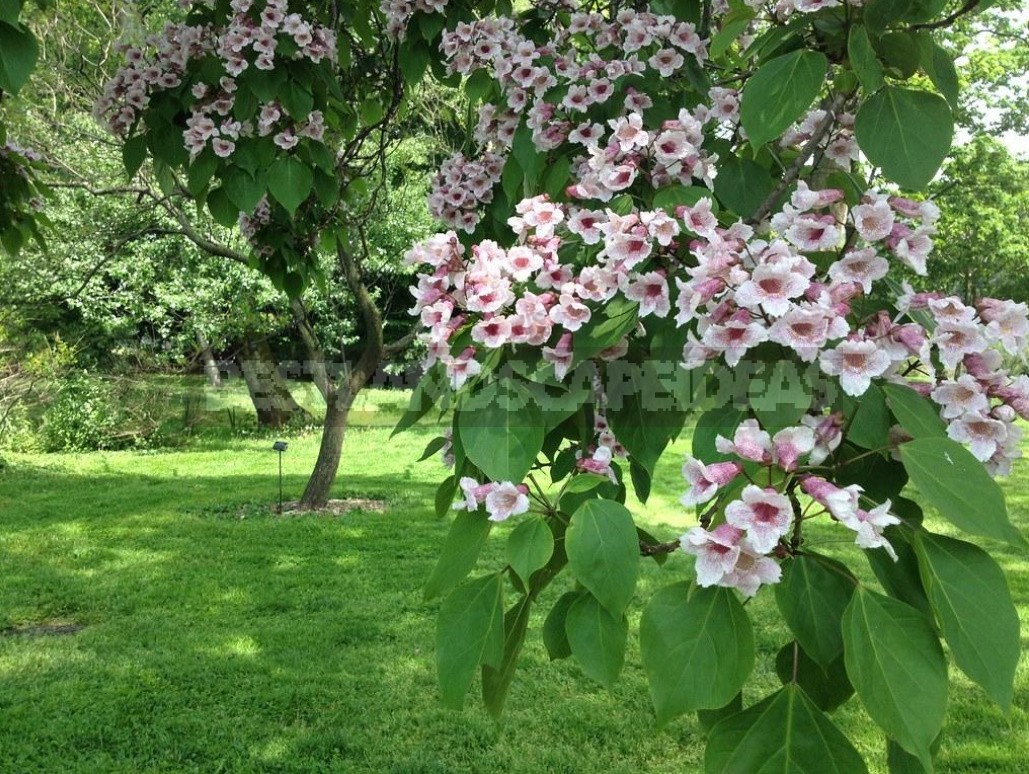
Catalpa bungei is a deciduous tree with a height of 4-8 m (14-26 ft) and a width of 4-6 m (14-20 ft) .The leaves are heart-shaped, large. The flowers are light pink, blooming in June-July. Often it is formed in the form of a stem tree with a beautiful tent-shaped (semi-circular) crown. Winter hardiness meets USDA zones 4b-9b.
Catalpa duclouxii
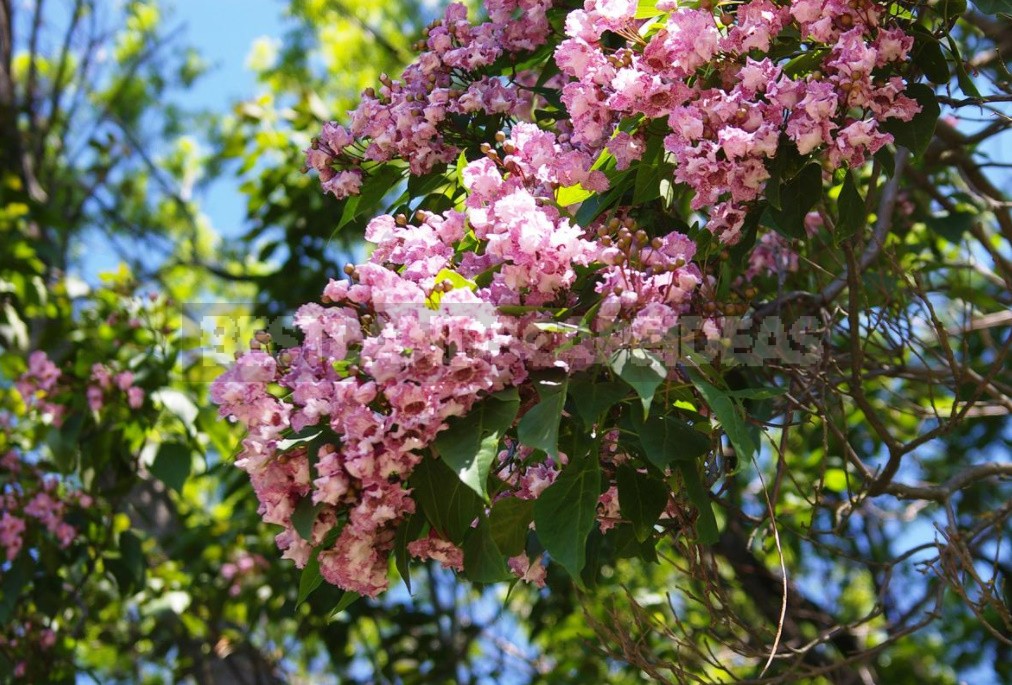
Catalpa duclouxii is a narrow-crowned tree up to 10 m (32 ft) tall. It is originally from China. The leaves are small, heart-shaped and elongated. The flowers are pale lilac, pink; they bloom from mid-May. Fruits are rarely tied. Its winter hardiness corresponds to USDA zones 4b-9b.
Catalpa fargesii
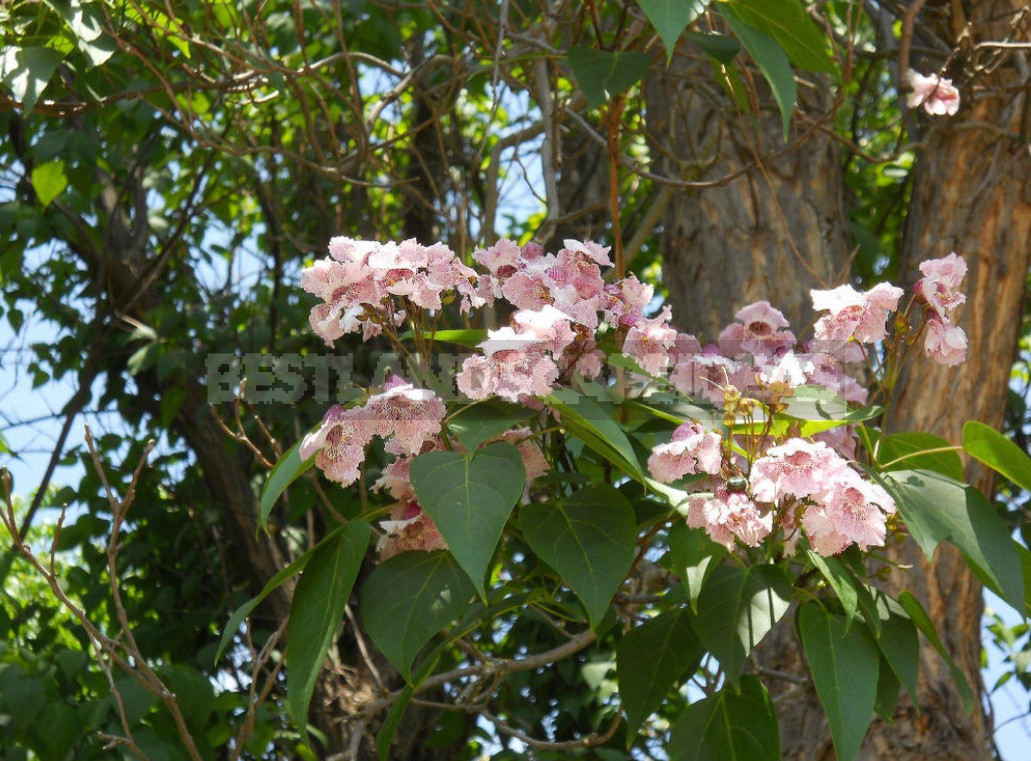
Catalpa fargesii is a deciduous tree with a rounded crown more than 10 m (32 ft) high. It is native to Central China, so it is often called the “Chinese bean tree” – probably because of the similarity of the narrow long fruit-boxes with beans. Winter hardiness corresponds to USDA zones 5-7.
Spectacular pink with purple-brown speckled flowers (blooms in May-June) and young bronze small leaves. Its ecological plasticity is striking — it can grow both in wet lowlands and in dry areas with poor soil. The disadvantages include the fragility of branches and the vulnerability of leaves to hail, wind.
Growing and Reproduction
All Catalpa grow well and bloom in fertile, drained, moist soils, but put up with dense, clayey ones with plenty of light, endure shading. Propagated by seeds in autumn or spring (seeds are stored on average for 1.5 years). Before sowing, they are soaked in water for a day. The depth of seeding is 1-1.5 cm (0.4-0.6 inch). Ground germination is from 32% to 78% (depending on the type).
Paulownia
Paulownia is a very spectacular fast-growing deciduous tree from the family Scrophulariaceae. The beauty of the flowering is not inferior to Jacaranda, with which they are not related at all, but the similarity is obvious. Paulownia is native to the East Asian floral region. In the culture, only 2 species are most widespread.
Paulownia tomentosa
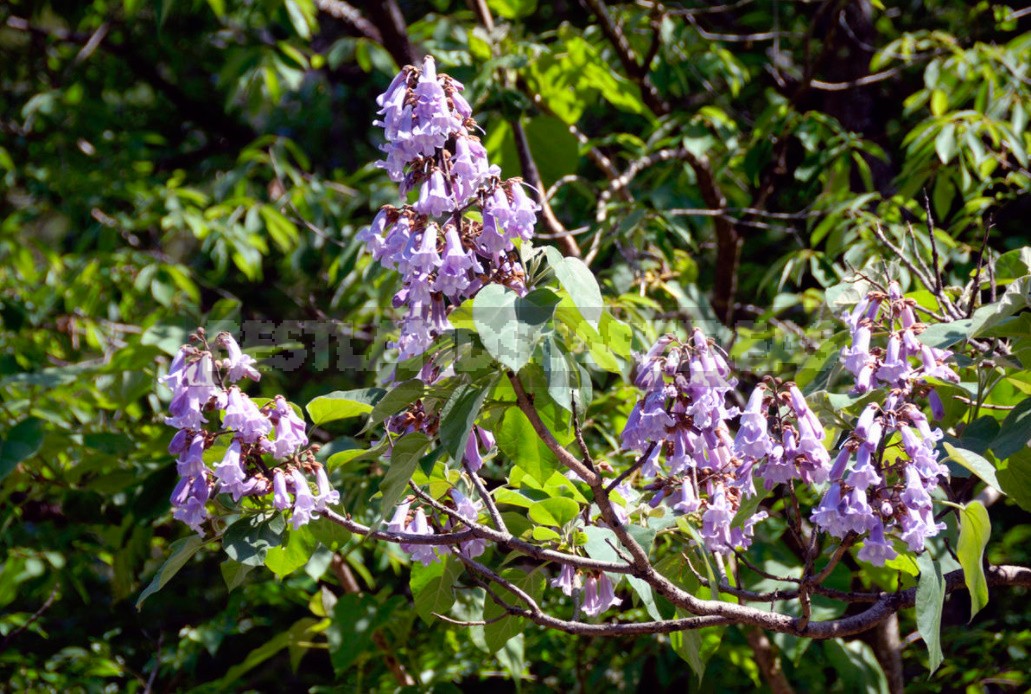
Paulownia tomentosa, syn. P. imperialis is also called the empress tree, the fox tree, the princess tree, and the Adam tree. According to the Missouri Botanical Garden, its winter hardiness is USDA zone 5-8.
It is a large tree with a sparse, widely columnar crown, thick branches, up to 12 m (40 ft) high and 10 m (32 ft) wide. Originally from China, Korea. The leaves are ovate, soft-pubescent, up to 30 cm (12 inch) long. The flowers are bell-shaped, lilac, with purple and yellow spots, fragrant, up to 5 cm (2 inch) long, collected in erect panicles at the ends of the shoots; they bloom in April-May, before the leaves appear. Interestingly, brown-pubescent buds are formed from the autumn of the previous year, so in some southern regions it develops well, but does not bloom. Fruits-boxes with small flying seeds.
Growing and Reproduction
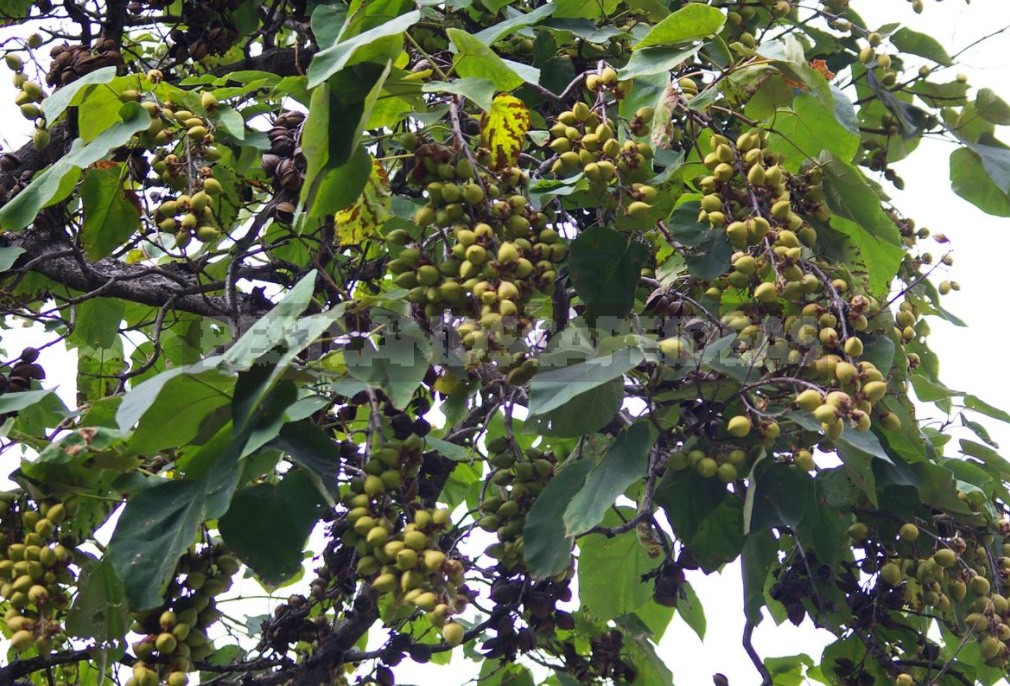
Let me remind you that its winter hardiness according to the USDA is zones 5-8. But! Young seedlings up to 2 m (6.5 ft) high, whose wood has not fully matured, especially in the first 3-5 years after planting, are particularly vulnerable. So that Paulownia does not freeze and bloom, do not rush to plant it in the open ground. It is necessary to leave the seedling for 1-2 years, especially if it is weak and grows poorly, to winter in a non-freezing room; watering should be reduced. After planting, the first 3-5 years before wintering in the open ground, you should take care of insulation: wrap the trunk with agrofibre and fix it so that it does not break off in the wind. The base of the trunk also needs to be protected from the cold, for example, to make a “collar” of covering material and dry leaves. By the 6th year after planting, the paulownia adapts, the wood matures, and then the plant will successfully winter and bloom.
Paulownia fortunei
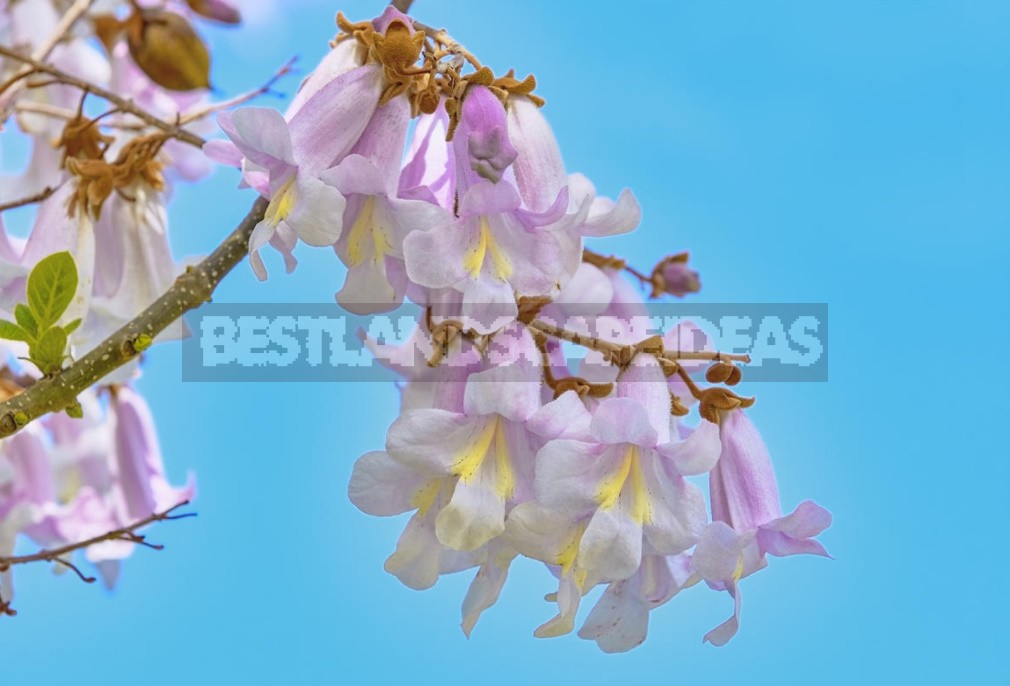
Paulownia fortunei is a tree with a broadly columnar crown, 8 m high and 8 m (26 ft) wide, with strong branches. Relatively hardy: USDA zones — 5b (7a) – 9b.
She is originally from China, Taiwan. The leaves are ovate, 20 cm (8 inch) long, shiny above and softly pubescent below. The flowers are 10 cm (4 inch) long, fragrant, from light purple to creamy white, collected in erect panicles; they bloom in May.
Growing and Reproduction
Paulownia loves fresh, loose, acidic soils and lighted places. Regular watering is required in the first year of planting, from the 2nd to the 5th — as the topsoil dries, and from the 6th year it is enough to organize watering in a dry summer. Your Paulownia will be more elegant if in the first five years after planting you take care of its nutrition: one fertilizing with mineral fertilizers in the spring, at the beginning of the growth of young shoots and one autumn, in September — with phosphorus-potassium fertilizers (application — according to the instructions) will be enough. If desired, it is possible to close the trunk circle only for the 6th year after planting, and until then the soil is maintained in a clean and loose state.
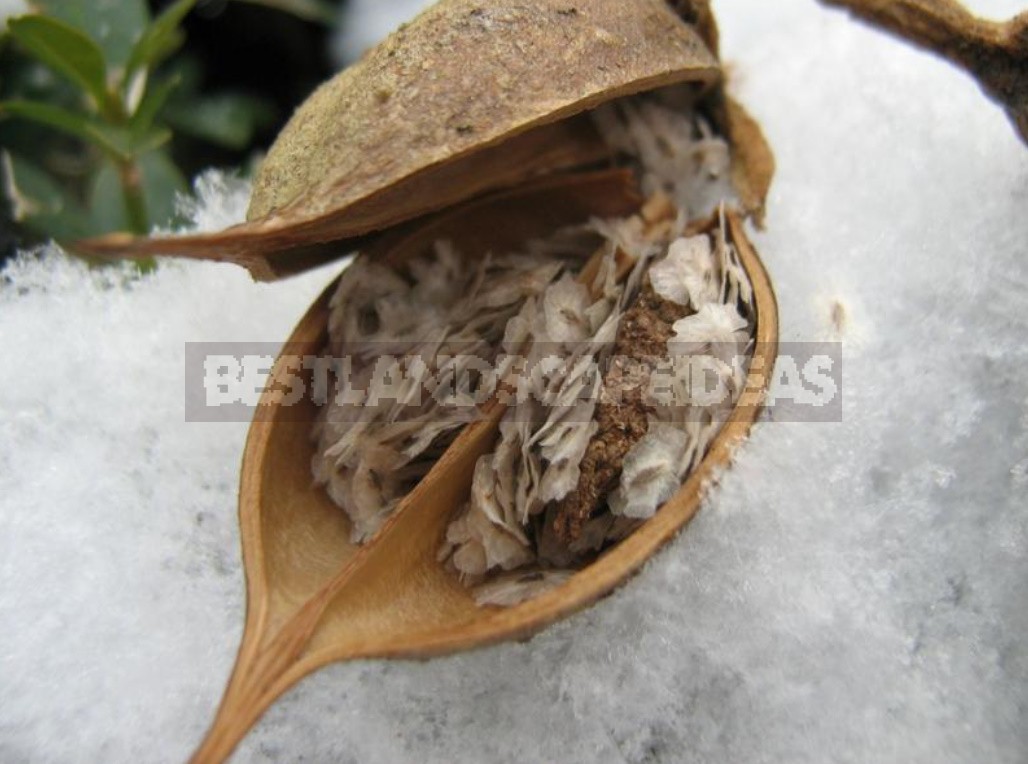
Pruning of Paulownia consists in the following: in cleaning the trunk from branches to a height of up to 1-2 m (3-6 ft), in shortening the shoots that protrude beyond the crown, in removing dry and broken shoots, overgrowth. Old specimens — but only if necessary-are carried out rejuvenating pruning, which consists in shortening by 2/3 of all skeletal branches.
Propagate by freshly picked seeds without embedding in the soil, which at +30°C (86°F) germinate on a moist and shaded surface for 8 hours! In the south, Paulownia tomentosa produces self-seeding.
This concludes my story about the sapphire trees. However, the topic of rare wood is not yet exhausted! While you choose the candidates for planting, I will prepare another interesting material about exotic walnut trees.
